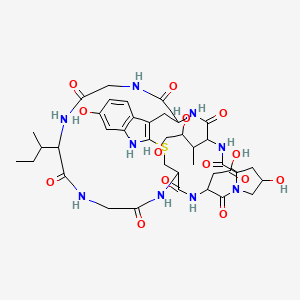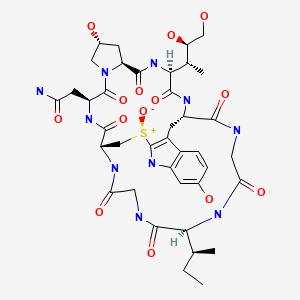Attribution Statement: LactMed is a registered trademark of the U.S. Department of Health and Human Services.
NCBI Bookshelf. A service of the National Library of Medicine, National Institutes of Health.
Drugs and Lactation Database (LactMed®) [Internet]. Bethesda (MD): National Institute of Child Health and Human Development; 2006-.
CASRN: 11030-71-0; 23109-05-9; 58250-15-0


Drug Levels and Effects
Summary of Use during Lactation
Amatoxins are water soluble, heat stable polypeptides found in Amanita (most often Amanita phalloides ), Galerina and some Lepiota species. The main toxin from the species A. phalloides is alpha-amanitin, a cyclic octapeptide. It is a potent inhibitor of RNA polymerases that blocks the production of mRNA and protein synthesis in liver and kidney cells.[1] In one case, an infant developed elevated liver enzymes after nursing once 11.5 hours after maternal ingestion of Amanita phalloides. However, two recent, well-documented cases found no adverse effects in breastfed infants and no amatoxin in the milk. Nevertheless, mothers suspected of having Amanita mushroom poisoning probably should not breastfeed until they have recovered or toxicologic screening of the breastmilk has ruled out.
Drug Levels
Maternal Levels. A 32-year-old mother shared a meal of foraged mushrooms (Amanita bisporigera), and developed symptoms 15 hours post-ingestion. Amatoxin was undetectable in the milk, although the timing of the milk sample was not stated.[2]
A 33-year-old woman picked about 200 mushrooms in the forest in France. She cooked and ate some of them, then breastfed her 5-month-old daughter 3 times a day over the next 36 hours. The mushrooms were identified as mainly Amanita phalloides along with Paxillus involutus, Amanita rubescens, and Chlorophyllum rhacodes. The mother’s urine collected in the emergency department was positive for amatoxin. A breastmilk sample collected 41 hours postingestion had no detectable amatoxin by LC-MS/MS.[3]
Infant Levels. Relevant published information was not found as of the revision date.
Effects in Breastfed Infants
In Germany, a 20-year-old nursing mother ate a meal of solely mushrooms identified in the report as green tuberous mushroom (Amanita phalloides). The next morning around 11.5 hours after mushroom ingestion, she nursed her 10-week-old infant who weighed 5 kg. The meal consisted of 80 to 100 mL of breastmilk and the same amount of ready-to-use infant formula (Milasan-Neu). At this time the mother already had symptoms of intoxication (vomiting and diarrhea). Because of the deterioration in her condition she was unable to continue breastfeeding the child, so the child received only formula thereafter. After the mother was admitted to the hospital for Amanita phalloides poisoning and had ASAT and ALAT values of 10,000 and 40,000, respectively (normal values about 500-550). The infant was placed under inpatient observation at children’s hospital. The infant’s relatives noticed nothing unusual about the child and the clinical admission examination revealed no visible evidence of a hepatic, cerebral or hematological disease. Six days after maternal mushroom ingestion, the infant’s laboratory values (electrolytes, serum electrophoresis, bilirubin, gamma-GT, alkaline phosphatase, creatinine, blood sugar, urine status, PTT, and PT [Quick test]) were normal except for ASAT and ALAT, which were about double the normal value. These values slowly decreased and became normal at about day 40 after ingestion.[4]
A 32-year-old mother shared a meal of foraged mushrooms (Amanita bisporigera), and developed symptoms 15 hours post-ingestion. She presented to the emergency department 29 hours post-ingestion and was found to have markedly elevated liver enzymes. Her 4 month-old-daughter had breastfed 4 hours post-ingestion. The asymptomatic infant was evaluated 48 hours after breastfeeding and discharged from the emergency department with no evidence of hepatotoxicity.[2]
A 33-year-old woman picked about 200 mushrooms in a forest in France. She cooked and ate some of them, and developed nausea, vomiting and diarrhea 11 hours post-ingestion. She was admitted to the hospital for treatment and had elevated liver enzymes. She had breastfed her 5-month-old daughter 3 times a day over the 36 hours after mushroom ingestion. Her daughter was hospitalized, but did not present any symptoms, nor any biological disturbance.[3]
Effects on Lactation and Breastmilk
Relevant published information was not found as of the revision date.
References
- 1.
- Hydzik P, Bielanski W, Ponka M, et al. Usefulness of 13C-methacetin breath test in liver function testing in Amanita phalloides poisoning; breast feeding woman case. Clin Toxicol (Phila). 2008;46:1077–82. [PubMed: 18821093]
- 2.
- Shively RM, Nogar JN, Rella JG, et al. Got milk? A case series of an amatoxin-exposed family, including a breastfeeding mother and infant. Clin Toxicol (Phila). 2020;58:148–9. [PubMed: 31070058]
- 3.
- Galland J, Bourdic F, Yaouanc B, et al. Comment on Got milk? A case series of an amatoxin-exposed family, including a breastfeeding mother and infant. Clin Toxicol (Phila). 2021;59:770. [PubMed: 33475424]
- 4.
- Hallebach M, Kurze G, Springer S, et al. Knollenblätterpilzvergiftung über muttermilch. Z Klin Med. 1985;40:943–5.
Substance Identification
Substance Name
Amanita Mushroom Poisoning
CAS Registry Number
11030-71-0 23109-05-9 58250-15-0
Disclaimer: Information presented in this database is not meant as a substitute for professional judgment. You should consult your healthcare provider for breastfeeding advice related to your particular situation. The U.S. government does not warrant or assume any liability or responsibility for the accuracy or completeness of the information on this Site.
- User and Medical Advice Disclaimer
- Drugs and Lactation Database (LactMed) - Record Format
- LactMed - Database Creation and Peer Review Process
- Fact Sheet. Drugs and Lactation Database (LactMed)
- Drugs and Lactation Database (LactMed) - Glossary
- LactMed Selected References
- Drugs and Lactation Database (LactMed) - About Dietary Supplements
- Breastfeeding Links
- PubChem SubstanceRelated PubChem Substances
- PubMedLinks to PubMed
- Review Amatoxin-Containing Mushroom Poisonings: Species, Toxidromes, Treatments, and Outcomes.[Wilderness Environ Med. 2018]Review Amatoxin-Containing Mushroom Poisonings: Species, Toxidromes, Treatments, and Outcomes.Diaz JH. Wilderness Environ Med. 2018 Mar; 29(1):111-118. Epub 2018 Jan 8.
- Amatoxin Mushroom Toxicity.[StatPearls. 2024]Amatoxin Mushroom Toxicity.Horowitz BZ, Moss MJ. StatPearls. 2024 Jan
- Ribosomal biosynthesis of α-amanitin in Galerina marginata.[Fungal Genet Biol. 2012]Ribosomal biosynthesis of α-amanitin in Galerina marginata.Luo H, Hallen-Adams HE, Scott-Craig JS, Walton JD. Fungal Genet Biol. 2012 Feb; 49(2):123-9. Epub 2011 Dec 21.
- Occurrence and chemotaxonomical analysis of amatoxins in Lepiota spp. (Agaricales).[Phytochemistry. 2022]Occurrence and chemotaxonomical analysis of amatoxins in Lepiota spp. (Agaricales).Sarawi S, Shi YN, Lotz-Winter H, Reschke K, Bode HB, Piepenbring M. Phytochemistry. 2022 Mar; 195:113069. Epub 2021 Dec 26.
- Review [Amatoxin-containing mushroom poisoning: An update].[Rev Med Interne. 2023]Review [Amatoxin-containing mushroom poisoning: An update].Caré W, Bruneau C, Rapior S, Langrand J, Le Roux G, Vodovar D. Rev Med Interne. 2023 Nov 8; . Epub 2023 Nov 8.
- Amanita Mushroom Poisoning - Drugs and Lactation Database (LactMed®)Amanita Mushroom Poisoning - Drugs and Lactation Database (LactMed®)
Your browsing activity is empty.
Activity recording is turned off.
See more...
